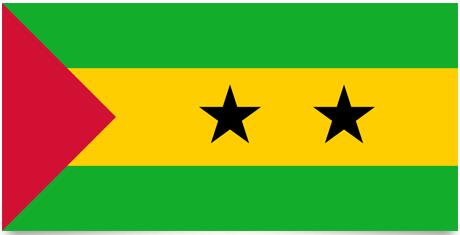São Tomé and Príncipe Flag and Meaning
Flag of São Tomé and Príncipe

São Tomé and Príncipe Flag Meaning
The flag is a minor reworking of the one used by the liberation movement MLSTP (Movimento de Libertação de São Tomé e Príncipe) in 1972. The country was a Portuguese colony from the 15th century until 1974. The difference between the two flags is that the two greens and the middle yellow band is equally wide in the MLSTP flag. In the national flag, the two green bands are slightly narrower than the yellow one.
The stars in the flag stand for the two islands of São Tomé and Príncipe. The colors are the traditional pan-African colors. The red triangle stands for the blood sacrificed in the struggle for freedom. The flag was adopted on November 5, 1975.
São Tomé and Principe Overview
| Population | 142682 |
| Currency | Dobra |
| Area | 960 km² |
| Capital city | São Tomé |
| Population density | 104.1 residents/km² |
| HDI location | 127 |
The country consists of the islands of São Tomé (857 km²), Príncipe (114 km²), and the small islands of Rolas, Cabras, Bombom and Boné de Joquei, located in the Gulf of Biafra in the Gulf of Guinea off the coast of Gabon. The islands are of volcanic origin, are mountainous with dense rainforests, tropical climate and extensive rainfall. The main export products are cocoa, copra and coffee.
The people: The inhabitants of São Tomé & Príncipe are predominantly Africans of Bantu origin. Traditionally, they are divided into 5 groups, according to the period in which they arrived in the country: filhos da terra (sons of the earth), are descendants of the first slaves to be transported to the islands and mixed with the Portuguese; the Angolans who apparently descended from Angolans who emigrated to the islands in the 16th century; forros are descendants of free slaves who revolted against the slave trade; serviçais are migrant workers from Mozambique, Angola and Cape Verde; tongasare their children born on the islands. Since independence, this division has gradually become blurred.
Religion: 80% of the population are Catholics; there are also Protestants (predominantly 7th-day Adventists) as well as members of the native evangelical church.
Language: Portuguese (official). The majority speak Creole – a language derived from Portuguese. Furthermore, a number of African languages are spoken.
Political parties: Movement to liberate São Tomé & Príncipe (MLSTP); Democratic Convergence Party (PCD); Democratic Coalition and Democratic Front.
Social organizations: Organizations for women, young people and children affiliated with MLSTP.
Official name: República Democrática de São Tomé e Príncipe.
Administrative Division: 7 districts
Capital: São Tomé, 56,000 in (2005).
Other important cities: Trinidade, 14,200 residents; Santana, 7,700 residents; Neves, 7,400 residents (2000).
Government: Evaristo Carvalho has been the country’s president since September 2016. Patrice Trovoada has been prime minister since August 2010. Parliament has one chamber: the National People’s Assembly with 55 members.
National Day: July 12 (Independence, 1975)













































